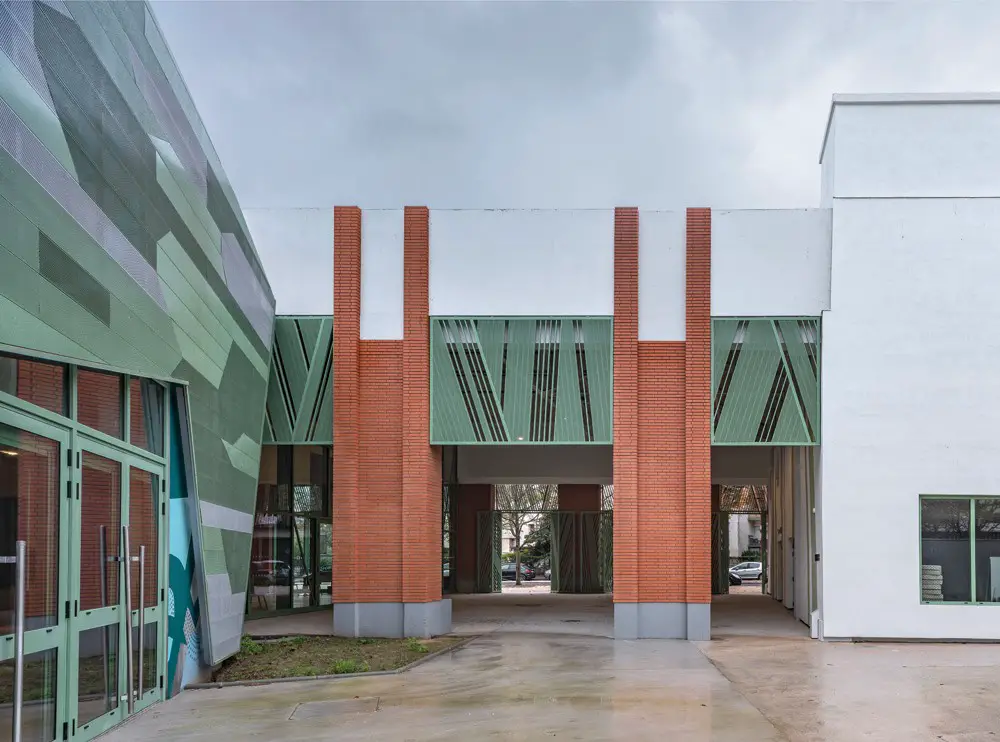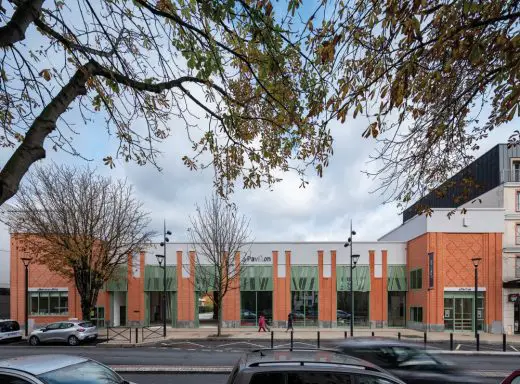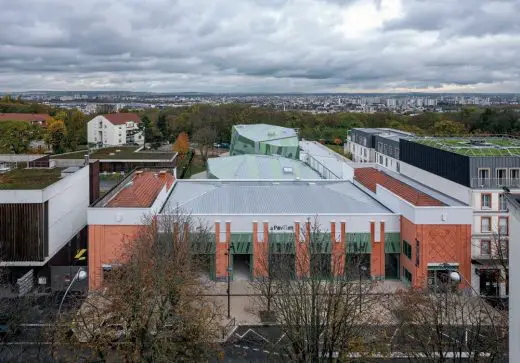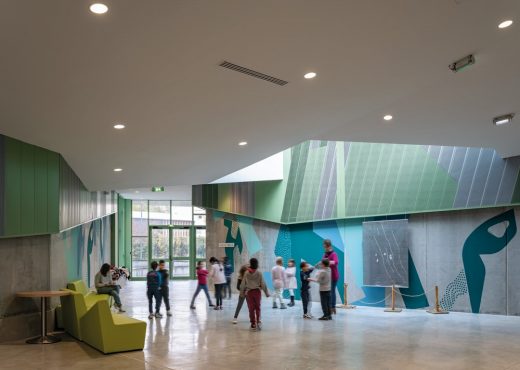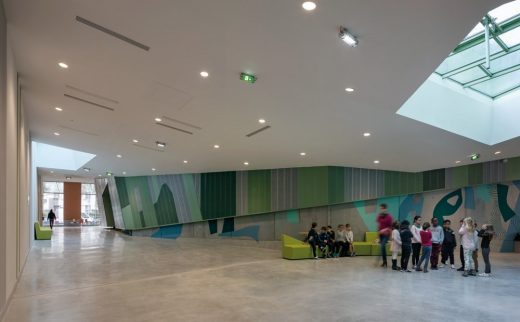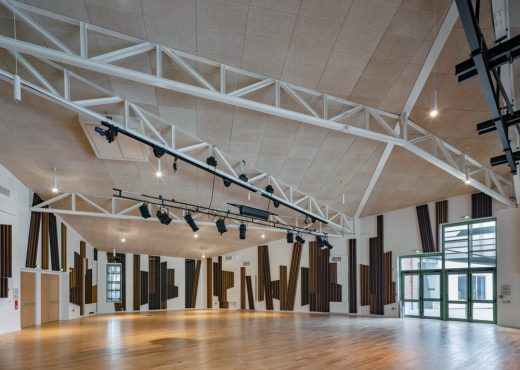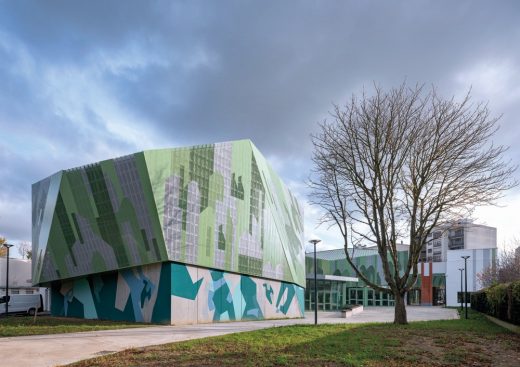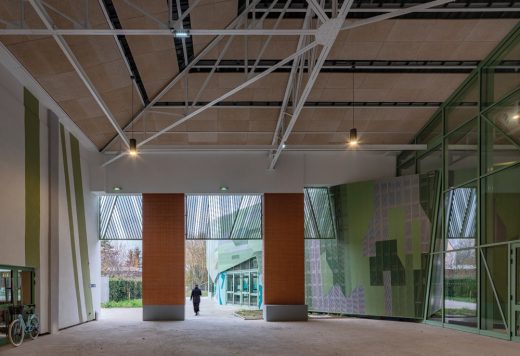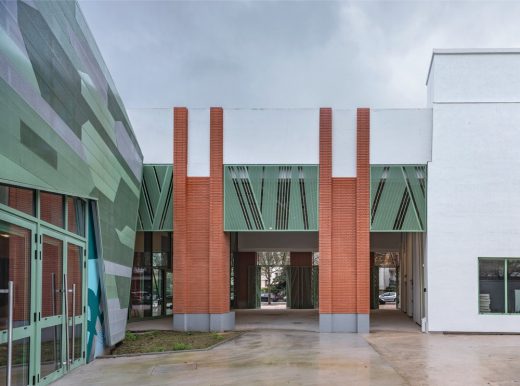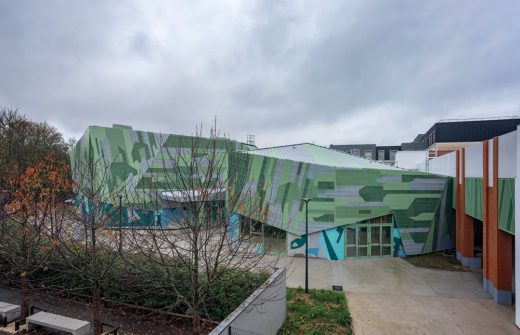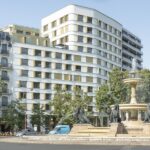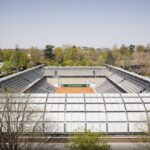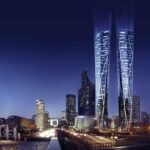Le Pavillon of Romainville, Parisian Auditorium, Show Room Building, French Architecture Photos
Le Pavillon of Romainville in Paris
19 Feb 2021
Le Pavillon of Romainville
Design: Miralles-Tagliabue EMBT and ilimelgo
Location: Romainville, Paris, France
Le Pavillon of Romainville, the green revelation for cultural heritage
• Through an organic response, Le Pavillon’s new architecture for citizenship creates green spaces connected to the forest and a place of life in the heart of Romainville.
• The sensitive architecture, respectful with the memory of the place, offers a tribute to the industrial past of Romainville and becomes a citizen meeting point that facilitates access to culture.
• The highly sustainable proposal dialogues and points out the value of the existing historical structure of the Polish Pavilion that belonged to the Universal Exhibition of 1937.
The transformation of Le Palais des Fêtes into Le Pavillon has been completed as the patrimonial protagonist of the city of Romainville in Paris, designed by Benedetta Tagliabue and her architecture studio Miralles-Tagliabue EMBT in collaboration with the french studio ilimelgo. The commission comes through a won competition to transform and give new functions to the small pre-existing building that needed a new life. New volumes have been added to the rehabilitated preexistence creating a complex that links the city, the new garden and the nearby forest. The cultural center is one more example of how Benedetta Tagliabue’s studio materialize its projects: an organic gesture capable of connecting with the most sustainable aspects for urban integration and the insertion of green in the city, taking care of the environment and the memory of the place.
Intertwined synergies: memory, culture and sustainability
The sensitive and adaptable architecture of Le Pavillon revalues the existing historical legacy and creates heritage for the enjoyment of the public. It is a space for coexistence for all audiences, open to different artistic expressions and practices, which strengthens the cultural fabric of Romainville. The community identifies with this space for which it feels a special collective pride, now renewed with the synergies between green and culture in an open place of life, in the heart of the city.
This new cultural center joins the different interventions that Benedetta Tagliabue’s studio develops in le Grand Paris, a metropolitan project that is redefining the city of the future under the values of accessibility, respect for the environment and the improvement of quality of life. Recently Benedetta Tagliabue has been awarded with the ARVHA 2020 Prix des Femmes Architectes, ex aequo with Anna Heringer, launched by the French Association for Research on the City and Habitat. The award shows the value that the French Ministry of Culture, the Pavillon de l’Arsenal and the National Council of the Order of French Architects give to the architect’s latest projects.
Dialogues with heritage for new organic connections
Taking care of what already exists, the project rehabilitates the structure of the Polish Pavilion for the Universal Exhibition of 1937, that formed the old Palais de Fêtes with a façade accessible from the street. The history of the Pavilion is thus incorporated into the new set of pieces, maintaining its leading role as the city’s cultural heritage and dialoguing with the new faceted volumes.
The sensitivity of the project strategy consists in creating new volumes organically connected with the old pieces, the new garden and the city. The value of ideas prevails over any excessive gesture. The care for the memory of the place determines the fit of the project, which is resolved with an accompaniment to the citizen: from the city to the garden and to the forest. With the designed garden, the green arrives to the city through the entrance hall that serves as a link at the street level. The street façade has been treated as a fundamental interface to allow this permeability with the urban environment. A game of opacities and transparencies in the apertures invites you to enter. The hall is both a meeting place and the articulation with the built volumes. On a larger urban scale, the new pieces that make up Le Pavillon connect with the landscape of the old quarries of the city and are located on the link between the periphery and the center of Paris.
Integration in the heart of the city, culture at street level
If the project on an urban scale attends and takes care of the connections with the environment and the city of Paris, on a small scale it prioritizes the user experience. Le Pavillon program is solved with the design of different pieces that allow multiplying the scenic and activity possibilities. The spatial organization favors a continuous and simultaneous use of its spaces: entrance and connection hall, event room and modular room. In addition, the center houses La maison de la filo, a unique space in France that promotes resources for the dissemination of philosophical thought and practices.
Le Pavillon is a highly sustainable project both for the idea of reusing the pre-existing pieces in a careful way, and for its integration into the environment creating new green spaces and the use of the materials produced in it. The two new volumes built have a double skin as a façade: exposed concrete and metallic layer with green shadows that remind us the proximity of the forest. The play of colors on the façade is integrated into the garden landscape and dialogues with the pre-existing pieces. The façade responds to a sustainable choice linked to the nature of Romainville in which the industry has had a transcendent historical and social role. It is a tribute to Romainville’s industrial past.
Rehabilitation And Extension Of Romainville’s Event Hall
Transformation Of The Events Hall To A Pavilion
A place steeped in history
The history of this building begins in 1937 with the construction of the Polish Pavilion in the « Universal Exhibition of Arts and Techniques Applied to Modern Life” in Paris. The mayor of Romainville, Pierre Kerautret, elected in 1935, bought the structure which was being dismantled. Its metal frame, originally being part of the Halls of the Pavilion, is therefore a precious witness to the history of Romainville. The mayor wanted to turn it into a gymnasium and the new building was the first institutional building to adorn Avenue Paul Vaillant Couturier. The framework was therefore flanked by two new buildings, the main facade of which, dressed in an “art deco” style, corresponds to the canons of this period. The construction was completed after the war, and was used as a cinema, festivities hall and cultural events. Over time, the original metal structure remained hidden and the volumes were altered and modified inside to respond to transient functional demands.
Rediscover and revalue
The project approach starts from the constant dialogue between the intervention and the existing parts of the building. The aim of the architectural intervention is to highlight the most important historical part (the metal structure) and to keep as much free space as possible on the plot to convert it into an accessible garden and open it to the public. An important point to be resolved was accessibility from the street, since the existing building was raised above the current level of the sidewalk.
Based on these guiding ideas, the new program is located in two new independent volumes, which perfectly meet the requirements of the program and which are in the form of two large crystals with angular shapes, different from the existing volumes and minimizing the impact. on the future garden.
Light, transparency and colours
The complete reordination of the blind facade towards the street led us to create a rhythm of large openings which connect the existing space of the old performance hall to the city. The historic metallic structure is unveiled and freed from any foreign element, reborn as the protagonist of this generous space, designed between the facade open to the street and the garden connected to the Corniche des Forts.
The old village hall is transformed, on the one hand, into a new reception area for future theatres and, on the other hand, into a porch open to the street which allows the public to access the back garden during the day. The old volume becomes transparent, permeable, without losing its character, and allows the garden to be seen from the street. This space becomes diaphanous, fills with natural light through the openings of the facade and becomes a porch and an access hall to the performance halls, offices, or the association “Maison de la Philosophie” installed in the west wing. The current levels are lowered to street level, thus making it possible to connect the street, the garden and the rest of the spaces on the ground floor on the same level.
The technical and storage spaces are in a separate volume, following the existing east wing. The artists’ access is separated by an independent entrance through the garden, as well as the access to the delivery area, completely separated from the flow of spectators and the public.
Each performance hall has a different atmosphere. The event room, open to the garden, has large bay windows that bring light and a feeling of space. The volume of the room penetrates the existing building and its completely new metal roof structure interprets the historic structure in a modern way. The acoustic treatment in irregular wooden battens becomes decorative. This room can be extended to the outside, leaving the garden doors open.
The second room is modular, intended for theatrical performances and concerts, dark in colour to better meet the needs of the program. The room configuration allows its use with modulated stands or without stands. It is accessed by 2 vestibules, one on each side, which lead directly to the middle of the room, and the volume is separated from the rest of the building by a small patio which illuminates the foyer and the spaces for the artists.
The two rooms have in common the treatment of the facades, carried out with 2 independent layers – one in exposed concrete painted in colours, which corresponds to the interior layer, and the other in sheet metal with different perforations and colours that make up the exterior volume. of the room. The material of the roof is the same as that of the facades, forming the irregular and singular volumes of the rooms. The designs on concrete are inspired by human figures dancing in motion, while the design of the perforated sheet metal in different colours and transparencies is inspired by a collage made from the combination of fragments of images of the city of Romainville – with fragments of its emblematic buildings such as its telecommunications tower, its historic buildings, its factories, the shed roofs… The use of metallic materials is a direct reference to the industrial and working-class past of this small town in eastern Paris.
All the interventions of the project are visible, and the new architecture can be read perfectly in the use of materials and in the volumetric composition. The building is completely transformed, opens towards the city and offers a recomposed image of the old volume, creating a dialogue between historical memory and the intervention of the project.
The intentions of the project can be read in the final result of this rehabilitation, and the people of Romainville of all ages have already appropriated the new cultural and social centre, as well as the garden. The generous and well-lit reception and circulation areas are privileged places for new scheduled or spontaneous activities.
Le Pavillon of Romainville in Paris, France – Building Information
Design: Miralles Tagliabue EMBT
Location: Romainville, Paris, France
Dates: 2017–2019
Client: Romainville Town Hall
Architects: Benedetta Tagliabue, chief architect
Miralles Tagliabue EMBT
Elena Nedelcu, project director
Local architects: ilimelgo architectes – Valerian Amalric, Maxime Potiron
Bureau d’études TCE: EPDC
Structural Engineer: IETI
Economist consultant: MEBI
Acoustic consultant: AVLS
Scenography: Tourny
Landscape consultant: Land’Act
Collaborators EMBT: Ana Otelea, Marzia Faranda, Vincenzo Larocca, Alessia Apicella, Marilena Petropoulou, Gabriele Rotelli, Ana Dinca, Andrea Marchesin, Antonio Soreca, Cristina Ghigheanu, Damiano Rigoni, Diana Santana, Eliza Neagu, Iago Pérez Fernández, Manousos Kakouris, Marco Loretelli, Marco Molinari, Marion Delaporte, Máté Géhberger, Salvatore Sapienza, Sara Mucciola, Silvia Plesea, Valentina Frigeni, Verónica Donà, Yasmine Fahmy.
Collaborators ilimelgo: Félicie Botton, Paul Lengereau, Héloïse Debroissia, Morgane Hamel, Marine Amand
Area: 2.735 sqm
Cost: 8.414.521,22 €
Typology: Rehabilitation and extension
Scope: Complete
Program: Auditorium, show room, offices, foyer, artists dressing rooms, services
Photography: Duccio Malagamba
Le Pavillon of Romainville, Paris images / information received 190221 from Miralles-Tagliabue EMBT architects, Barcelona
Location: Paris, France
New Paris Architecture
Contemporary Paris Architecture
Paris Architecture Design – chronological list
Paris Architecture Tours by e-architect
Design: MAD Architects ; Jacques Rougerie Architecture ; Atelier Phileas Architecture ; Apma Architecture
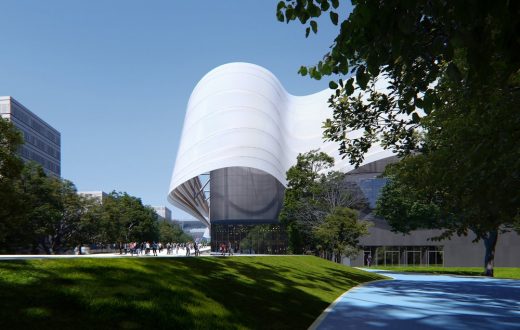
image courtesy of MIR
2024 Paris Olympics Aquatic Center
Design: Muoto Architects
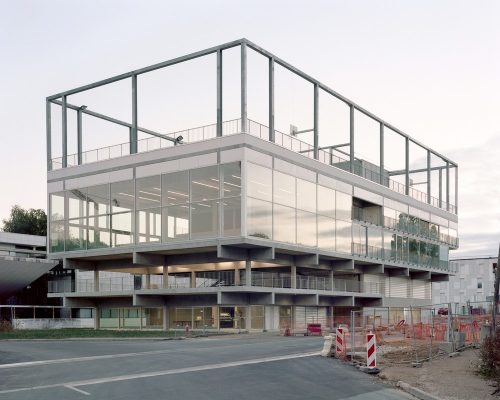
photograph : Maxime Delvaux
Public Condenser in Gif-sur-Yvette, Paris-Saclay
Comments / photos for the Le Pavillon of Romainville, Paris building design by Miralles-Tagliabue EMBT + ilimelgo page welcome

